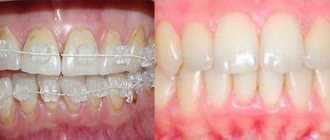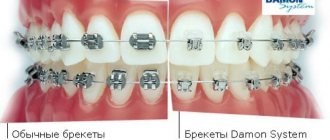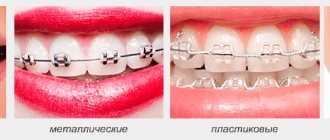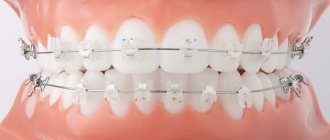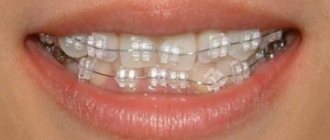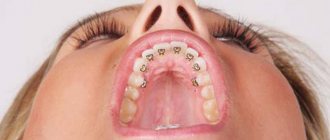What types of braces are there and how they work, how do they differ, how to choose the right design for yourself? To understand this issue, you need to structure the options and decide on their advantages/features.
Classification of bracket systems
At an appointment with an orthodontist, the patient will be offered different options for braces from those that the doctor considers optimal for a particular clinical case. When choosing which braces are best to install, you should focus on the following criteria:
- — type of fixation. There are ligature and self-ligating (or non-ligating) systems;
- - material of manufacture. In dentistry, braces are made from metal, ceramics or artificial crystal (sapphire);
- - location. There are external or vestibular structures, as well as internal or lingual ones.
When choosing, you need to consider: the cost of the braces system, the dentist’s recommendations, the importance of aesthetics and strength. If you are unsure which braces system to choose, don’t be afraid to ask your doctor questions.
Classification according to the principle of operation: ligature or non-ligature (self-ligating) braces
Depending on the type of fixation of the power arc to the clasps, braces can be ligature or non-ligature. Below we will look at the features of these two principles of system design.
Ligature braces involve the use of special elastic bands that gradually stretch. Therefore, the client has to visit the dentist monthly, or even 2 times a month, to check the tension of the arc and replace the ligatures if necessary.
Self-ligating braces (also known as non-ligating braces) - the clasps have special grooves in which the arch is fixed . This is a more modern solution that allows you to reduce the number of visits to the orthodontist to once every 2-3 months. This allows for smoother tooth movement. Also, it is easier to get used to non-ligature braces, and they help reduce treatment time and give a more predictable result.
Active and passive self-ligation
Self-ligation can be passive or active. With the active type of fixation, the bracket clip applies pressure and moves the archwire towards the base of the slot. The orthodontic arch, in turn, puts pressure on the clip. In the case of passive self-ligation, the cover fixes the archwire in the slot without exerting pressure on it. When closed, the bracket turns into a buccal tube: the static cover becomes the fourth wall of the groove, the arch moves freely and is not subject to force. Example: Damon Q.
Damon Q with orthodontic arch
Which braces are best for adults and pediatric patients? American orthodontist Vourdouris JC compared the frictional force of the arch in the bracket groove when using passive and active non-ligature structures. According to a study published in the American J. of Orthodontics & Dentofacial orthopedics, active systems operate with a high friction force of 31.0 g, while passive designs have a low friction force of 0.1 to 0.18 g.
The data obtained scientifically prove that passive self-ligating systems are able to interact with archwires throughout treatment without loss of force and provide a new standard of low friction when moving teeth. American scientists Thorstenson GA and Kusy supplemented the results of the study. Experts have found that when using the Damon System passive self-ligating system, there is significantly lower frictional resistance in dry and wet environments compared to active structures.
Studies conducted by orthodontists indicate the benefits of treatment with passive self-ligating braces.
Classification by material of manufacture
When thinking about which braces to choose based on the material of manufacture, you need to know the main advantages and disadvantages of each option:
- 1. Metal . The most durable classic systems that can cope with defects of any complexity and are the cheapest. Among the disadvantages: very noticeable, even if you install a self-ligating system with small locks, they can cause allergic reactions and irritation of the mucous membranes. Common ligature systems: Mini Diamond, non-ligature systems: Damon Q, Damon 3MX.
- 2. Ceramic . Braces are much less noticeable on the teeth and do not cause allergic reactions. The most common Damon systems are highly durable and efficient. The only drawback of such systems is their high cost.
- 3. Sapphire . They are made of artificial transparent material, due to which they are almost invisible on the teeth. However, they have increased fragility, so they are not suitable for advanced defects that require long-term correction. Popular option: Inspire ICE.
If you are unsure whether to choose ceramic or metal or sapphire braces, ask our orthodontist for advice. Depending on the severity of the defect and your wishes for aesthetics and cost, the doctor will select the best option.
Classification by location: vestibular and lingual braces
Another important criterion when choosing a brace system for bite correction is the location of the locks. There are two types of systems, each of which is actively used in orthodontics:
- 1. Vestibular braces (standard, visible). Classic designs that are attached to the front surface of the teeth. These braces allow you to correct any type of malocclusion, regardless of severity and complexity. However, even the most aesthetic clasps made of ceramic or sapphire will still be noticeable on the teeth.
- 2. Lingual braces (they are also called “invisible braces”, or internal). They are installed on the inner surface of the dentition, so they are completely invisible. Minus - they have a number of restrictions for use. In particular, they are not suitable for defects that are too complex .
If you are thinking about which braces are best for a girl, a shy child or an adult, then lingual systems are best suited. However, the decision must be made together with the orthodontist.
Contraindications
Situations when staples cannot be installed may vary. Temporary contraindications include:
- Poor oral hygiene. Then you first need to carry out professional hygiene.
- Untreated caries. First you need to “close” all carious cavities.
- Progressive pulpitis, periodontitis, periodontal disease, gingivitis. Any dental ailments must be treated before bite correction begins.
- Individual intolerance to metal, acrylic. You need to choose a device that is made of hypoallergenic material.
Among the absolute contraindications to staple correction of malocclusion:
- pulmonary tuberculosis;
- tumor neoplasms (with and without metastases);
- diabetes;
- epilepsy, severe neurological disorders;
- AIDS, HIV;
- mental disorders.
Before making and fixing brackets on your teeth, you must undergo a diagnosis and dental examination. The doctor will tell you whether it is possible to correct the bite in this way and when it is best to do it. Typically, during diagnostic procedures, radiography or panoramic tomography of the jaw is performed.
Invisible braces
This is a separate criterion when choosing a bracket system. After all, many patients are interested in the issue of the visibility of the structure on the teeth. If aesthetics is more important to you, then “invisible” braces include the following options:
- - ceramic;
- - sapphire;
- - lingual.
The first two types of systems involve the use of a non-ligature type of fixation. The clasps on these braces are small and rounded. In addition to the aesthetics parameter, they also do not have a negative effect on the soft tissues of the oral cavity. The third type, lingual, involves installing the system on the inside of the teeth; as a result, the braces are not visible at all.
Is it worth choosing such “invisible” systems? The exact answer is up to you. We advise you to focus not on aesthetics, but on efficiency, on which the final result and the duration of the entire treatment depend!
Which braces are easiest to care for?
Each type of braces requires careful care and caution when worn. Metal brace systems are less demanding in this regard, as they allow you to practically limit yourself in food. They are not painted, have high strength, and are resistant to temperature changes.
It is also quite easy to care for self-ligating systems, since they do not have ligatures in which food becomes clogged and plaque accumulates.
Which braces should a teenager or child choose?
Correcting the bite in children is a fairly common type of dental treatment. Parents often have to think about how to choose braces for a child or teenager. The best option is to listen to the advice of a pediatric orthodontist.
When discussing different options, it is worth taking into account the child's personality. If he is shy or has complexes, then it is better to install one of the “invisible” types of systems. But children, as a rule, are less concerned about aesthetics, so they are most often fitted with classic metal braces.
The best braces for adults
Treatment of malocclusion in adults takes longer and is more difficult than in children. Therefore, the choice of braces must be approached with special care. The following criteria are important:
- — severity of the defect;
- - general condition of teeth;
- — aesthetics;
- — convenience;
- - price;
- - strength;
- - expected duration of treatment.
There is no particular braces system that could be considered the best. Different orthodontic structures are suitable for each clinical case. If you are most interested in aesthetics, you should get lingual braces. In cases where you need a cheaper option, classic metal systems are suitable. Moreover, regardless of the situation, doctors usually recommend installing self-ligating structures, because This will reduce the number of appointments with the orthodontist, and they are also more effective.
Braces for children
Pediatric dentists use such systems quite often. They are easy to install, quickly removed and work well in conditions where the bite is not fully formed.
Parents can tell that a child has dental problems by the following signs:
- the enamel has sharply darkened and thinned, the baby complains of pain when chewing food;
- the child sleeps poorly at night, often sucks his thumb in his sleep;
- difficulties arise with nasal breathing (it is replaced by breathing through the mouth);
- The size of some dental crowns has decreased.
All of these signs indicate that some area of the mouth is placing too much stress on the jaw. If orthodontic treatment is not carried out in time, the situation will worsen. At an older age, problems with permanent bite may occur.
Conclusion
Choosing the right brace system depends on many parameters. In modern orthodontics, there are many different designs, each of which has advantages, disadvantages and may be the best option for a particular situation. When choosing braces for malocclusion treatment, you must, in addition to your own requirements, consult with an experienced orthodontist. You can undergo a comprehensive examination and consultation with a doctor, and then get high-quality, effective braces in our dentistry.
Posted by:



